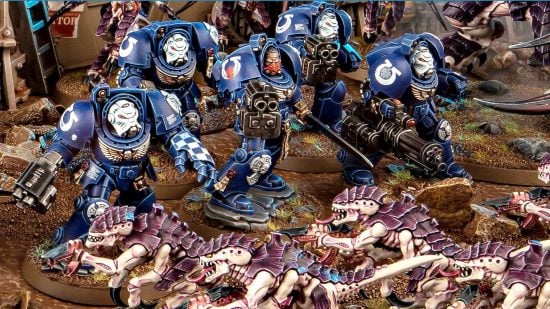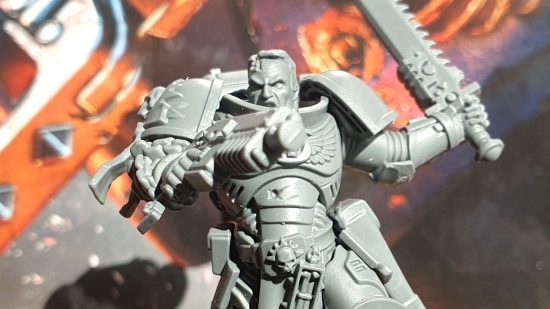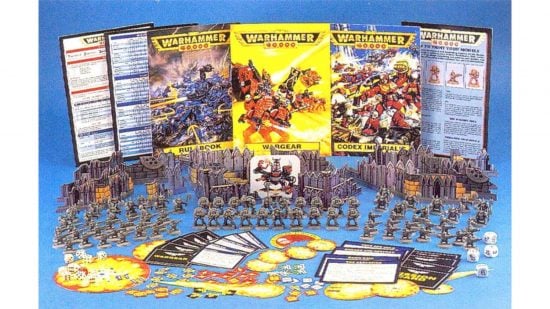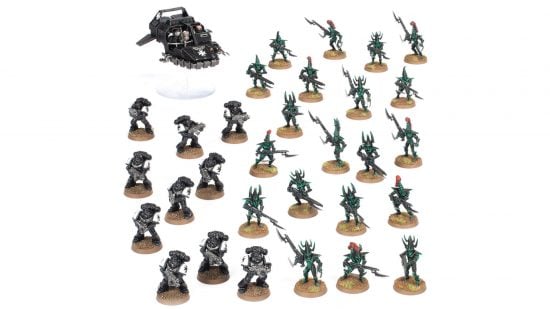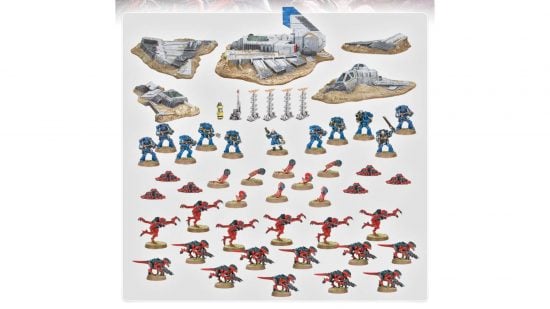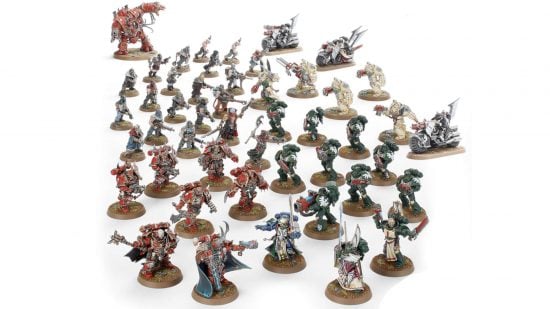This guide explains the differences between all the Warhammer 40k starter sets, including their cost, contents, and which set is right for you or the person you’re buying a gift for. It also has info on other ways you can get started with the ultimate sci-fi miniatures game.
New 40k players can feel bombarded with confusing questions: which Warhammer 40k faction should I play? What is a Warhammer 40k codex and why should I get one? Come to think of it, what is Warhammer 40k, anyway, and why are Space Marines‘ shoulder pads so big?
Fortunately, all the different Warhammer 40k starter sets do a good job of introducing new players to the game. Some allow you to dip your toes into the shallow end of the hobby, others will help you dive in head first – it just depends on what you want to do and what your budget is.
Why you can trust us ✔ We spend hours testing games, toys, and services. Our advice is honest and unbiased to help you buy the best. Find out how we test.
Past Warhammer 40k starter sets
These are the past Warhammer 40k starter sets from previous editions of the game.
Warhammer 40k Rogue Trader starter set
There was no Warhammer 40k Rogue Trader starter set! Released in 1987, the very first edition of Warhammer 40k came before Games Workshop started making game-in-a-box wargames: this would start with Adeptus Titanicus, which launched in 1988
Warhammer 40k second edition starter set
The Warhammer 40k Second Edition starter set featured iconic cover art by John Blanche, depicting Blood Angels Space Marines facing off against hordes of Orks. The box contained 20 monopose Space Marines, 20 monopose Orks, 40 monopose Gretchin, and a cardboard Ork dreadnought standee (now called a Deffdread). The rules were split into three softback rulebooks, and the box contained a tidal wave of cardboard tokens, data cards, and cardboard terrain.
Warhammer 40k third edition starter set
The Warhammer 40k third edition starter set once again used John Blanche cover art, this time a montage of Black Templars space marines. The models included were 10 multipart Space Marines, a Space Marine Land Speeder, 20 Dark Eldar raiders, and terrain. This box introduced the see-through blast and flamer templates still used today, and consolidated all the rules into a single softback rulebook.
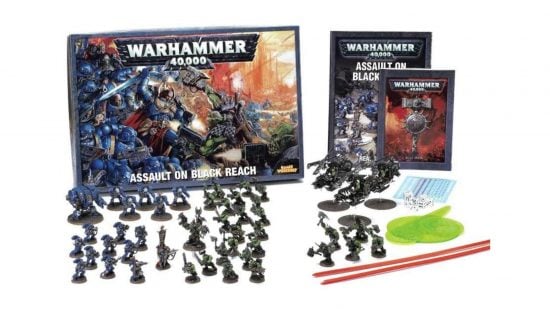
Warhammer 40k fourth edition starter set
The Warhammer 40k fourth edition starter set was the first named starter set, ‘Battle for Macragge’, and even had a matching narrative about the Tyranid invasion of the Ultramarines homeworld. The box contained monopose figures once again: 10 Space Marines, 10 Tyranid termagants, six Tyranid genestealers, eight Tyranid spore mines, a stranded Imperial navy pilot, and terrain representing his crashed Aquila shuttle. The rules were shrunk into a digest A5 format.
Warhammer 40k fifth edition starter set
The Warhammer 40k fifth edition starter set was ‘Assault on Black Reach’, pitting the Orks against the Ultramarines once again. The box contained complete (if small) armies for the first time: 10 Space Marine tactical marines, a Space Marine captain, a Space Marine Dreadnought, against 20 Ork Boyz, five Ork Nobz, an Ork Warboss, and three Ork Deffkoptas.
Warhammer 40k sixth edition starter set
The Warhammer 40k sixth edition starter set was ‘Dark Vengeance’. This box again featured two armies, the Dark Angels and the Chaos Space Marines. The Dark Angels force contained 10 Space Marine tactical marines, five Deathwing terminators, three Ravenwing bikers, a Librarian, and a Captain, while the Chaos Space Marines fielded a Helbrute, six Chaos Chosen, twenty Chaos Cultists, and a Chaos Lord. The first wave of the box also contained a Dark Angels Interrogator Chaplain.
Warhammer 40k seventh edition starter set
The Warhammer 40k seventh edition starter set was also ‘Dark Vengeance’, with the same miniatures as the sixth edition box set but updated rules.

Warhammer 40k eighth edition starter set
The first Warhammer 40k eighth edition starter set was Dark Imperium. This contained two sizeable armies, one introducing the Primaris Space Marines, and the other launching a new range of Death Guard. It also contained a hardback rulebook. Two smaller starter sets were also sold, First Strike, which had a handful of models and basic getting started rules, and Know No Fear, which had about half the models of Dark Imperium and a slightly more involved beginners rulebook.

Warhammer 40k ninth edition starter sets
There were four Warhammer 40k ninth edition starter sets in total, starting with the limited edition launch box set Indomitus. This introduced two large armies of monopose figures, expanding the Primaris Space Marines range and launching a refreshed Necrons line. It also contained a full hardback rulebook.
The launch box set was followed by three tiers of starter set: Recruit edition, which had very basic rules and a few miniatures; Elite edition, which had more substantial armies for both sides; and Command edition, which had the same models as Elite edition but added a full rulebook and gaming terrain.
